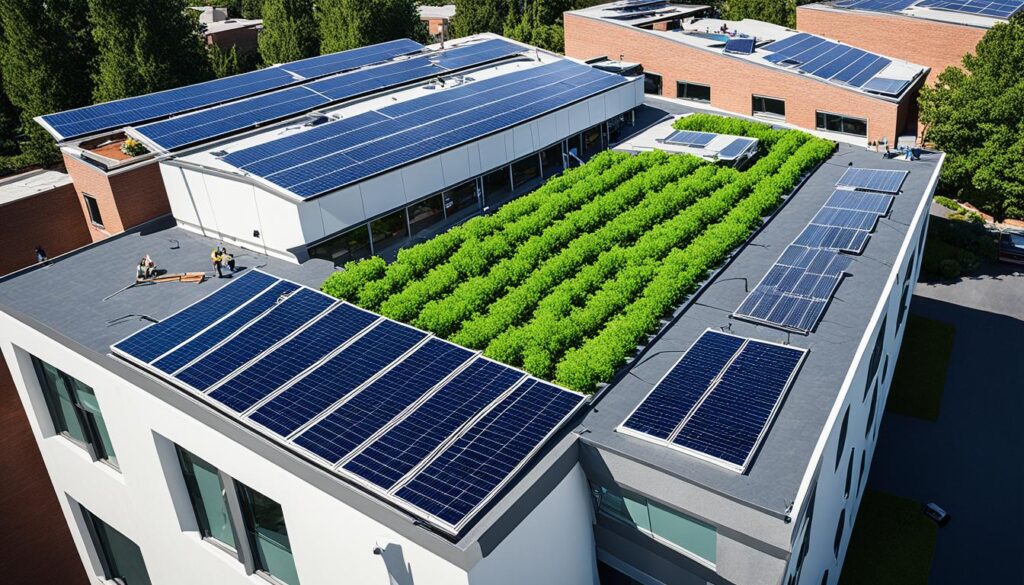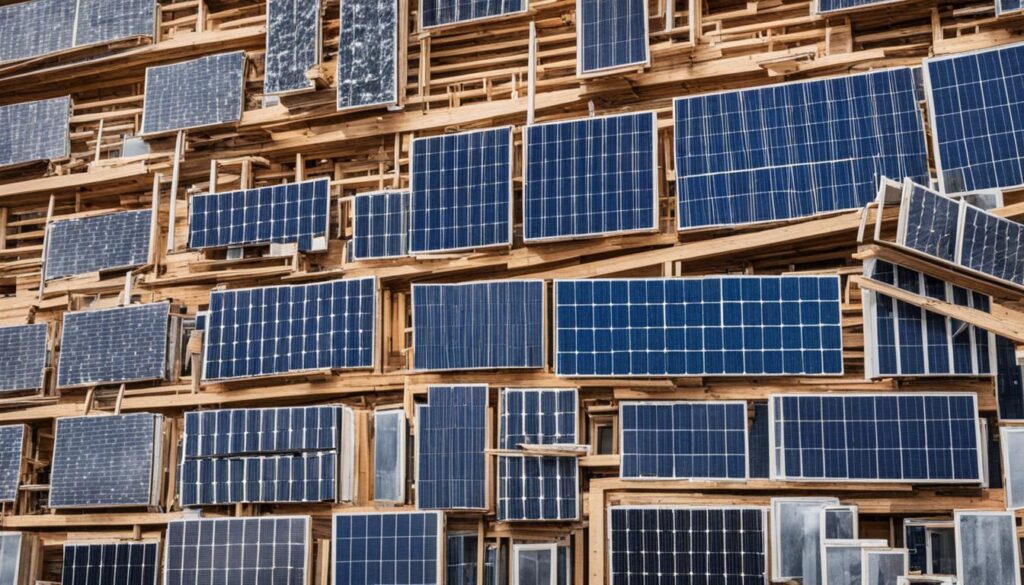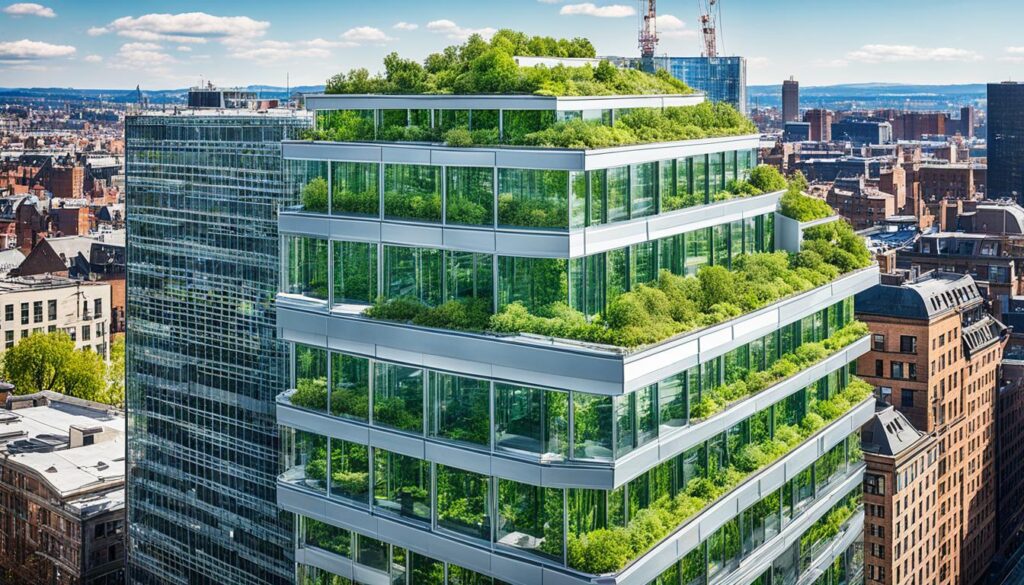Are older buildings destined to be energy-drainers, or can they be transformed into sustainable and efficient structures? We explore the world of sustainable retrofitting, where environmentally conscious upgrades breathe new life into older buildings, improving their energy efficiency and reducing their environmental impact.
Key Takeaways
- Sustainable retrofitting involves upgrading older buildings for improved energy efficiency and reduced environmental impact.
- Benefits of sustainable retrofitting include enhanced energy efficiency, reduced carbon emissions, water conservation, and waste management.
- Technological innovations play a crucial role in advancing sustainable retrofitting solutions.
- Water efficiency measures and the use of sustainable materials further contribute to a greener built environment.
- Sustainable retrofitting offers significant economic benefits, including energy cost savings and increased property value.
The Benefits of Sustainable Retrofitting
Sustainable retrofitting offers numerous benefits, including enhanced energy efficiency and reduced environmental impact. By integrating energy-efficient technologies, such as LED lighting, smart building systems, and improved insulation, older buildings can significantly reduce their energy consumption and contribute to a greener future. Additionally, sustainable retrofitting helps reduce carbon emissions, conserve water, and manage waste effectively. These benefits have both environmental and economic implications, making sustainable retrofitting a valuable investment for building owners.
Enhanced Energy Efficiency
The integration of energy-efficient technologies in sustainable retrofitting projects results in improved energy efficiency. By upgrading lighting systems to energy-efficient alternatives, such as LED lights, older buildings can reduce their energy consumption for lighting purposes. Upgrading insulation also plays a crucial role in enhancing energy efficiency by preventing thermal leaks and reducing heating and cooling costs.
The following table highlights the potential energy savings achieved through sustainable retrofitting:
| Before Retrofitting | After Retrofitting | |
|---|---|---|
| Energy Consumption | High | Significantly Reduced |
| Utility Costs | High | Lowered |
As shown in the table, sustainable retrofitting can lead to significant reductions in energy consumption and utility costs, resulting in long-term savings for building owners. These energy efficiency improvements also contribute to a more sustainable future by reducing reliance on fossil fuels and decreasing carbon emissions.
Reduced Environmental Impact
Sustainable retrofitting not only improves energy efficiency but also reduces the environmental impact of older buildings. By implementing energy-efficient technologies and practices, retrofitting projects help decrease carbon emissions, conserve water, and manage waste effectively. The infographic below illustrates the reduced environmental impact achieved through sustainable retrofitting:
“Sustainable retrofitting helps create more sustainable and efficient buildings, minimizing their environmental footprint and contributing to a greener future.” – Green Building Council
Economic Implications
In addition to the environmental benefits, sustainable retrofitting offers significant economic advantages. By reducing energy consumption and utility costs, retrofitting projects generate long-term energy cost savings for building owners. Moreover, many governments and organizations provide financial incentives and grants to support sustainable retrofitting, further reducing the overall project costs. Furthermore, sustainable retrofitting enhances the market value of buildings, attracting potential buyers and tenants who prioritize energy-efficient and environmentally conscious spaces. The following list summarizes the economic benefits of sustainable retrofitting:
- Energy cost savings
- Financial incentives and grants
- Increased property value
These economic benefits make sustainable retrofitting a valuable investment that not only benefits the environment but also provides a positive return on investment for building owners.
Enhancing Energy Efficiency in Retrofitting
Sustainable retrofitting plays a crucial role in enhancing energy efficiency in older buildings. By upgrading lighting systems to energy-efficient alternatives, such as LED lights, buildings can significantly reduce their energy consumption and improve lighting quality. Upgrading insulation helps prevent thermal leaks, leading to reduced heating and cooling costs. Integrating smart building systems, including automated thermostats and occupancy sensors, optimizes energy use by adjusting heating, cooling, and lighting based on occupancy.
One of the key aspects of enhancing energy efficiency in retrofitting projects is upgrading the lighting systems. By replacing traditional lighting fixtures with energy-efficient alternatives, such as LED lights, buildings can achieve significant energy savings. LED lights consume less energy and have a longer lifespan compared to traditional incandescent or fluorescent lights. Moreover, they provide better lighting quality, enhancing the overall ambiance and comfort of the space.
Upgrading insulation is another critical factor in improving energy efficiency. By installing upgraded insulation materials, such as spray foam or cellulose insulation, buildings can prevent thermal leaks and minimize heat transfer. This leads to reduced heating and cooling costs as the indoor temperature remains more stable. Proper insulation also helps enhance indoor comfort by reducing drafts and cold spots.
Integrating smart building systems is another effective way to enhance energy efficiency in retrofitting projects. Automated thermostats, for instance, allow precise control of heating and cooling based on occupancy schedules and temperature settings. This helps optimize energy use by ensuring that energy-consuming systems are only active when required. Occupancy sensors can automatically adjust lighting and HVAC settings based on occupancy, further reducing unnecessary energy consumption.
Key Benefits of Enhancing Energy Efficiency
Enhancing energy efficiency in retrofitting projects offers numerous benefits:
- Significant energy savings, reducing energy consumption and costs
- Improved lighting quality and comfort for building occupants
- Reduced carbon footprint and environmental impact
- Enhanced indoor air quality and thermal comfort
- Increased property value and marketability
“Enhancing energy efficiency in retrofitting projects helps create sustainable and energy-conscious buildings that benefit both the environment and building owners.”
Case Study: Energy-Efficient Lighting Upgrade
| Building Type | Energy Savings | Return on Investment (ROI) |
|---|---|---|
| Office Building | 30% | 2 years |
| Retail Store | 40% | 1.5 years |
| Hospital | 25% | 3 years |
By upgrading the lighting system in an office building with energy-efficient LED lights, a 30% reduction in energy consumption was achieved, resulting in a return on investment (ROI) within 2 years. Similarly, a retail store achieved a 40% reduction in energy consumption and an ROI within 1.5 years. In a hospital setting, energy-efficient lighting upgrades led to a 25% reduction in energy consumption and an ROI within 3 years. These case studies demonstrate the significant energy savings and financial benefits of enhancing energy efficiency through lighting upgrades.
Reducing Environmental Impact through Retrofitting
Sustainable retrofitting is a crucial approach to reducing the environmental impact of older buildings. By implementing energy-efficient technologies and adopting sustainable practices, retrofitting projects contribute to climate change mitigation efforts, decrease carbon emissions, conserve water, and promote effective waste management.
Decreased Carbon Emissions
One of the key benefits of sustainable retrofitting is the significant reduction in carbon emissions. By incorporating energy-efficient technologies, such as LED lighting, smart HVAC systems, and energy management systems, older buildings can minimize their energy consumption and contribute to global efforts in combatting climate change.
Water Conservation
Water conservation is another important aspect of retrofitting projects. Implementing water-efficient fixtures and incorporating rainwater harvesting systems allows older buildings to reduce water consumption and alleviate strain on local water supplies. These measures not only conserve water resources but also contribute to the overall sustainability of the building.
Waste Management
Sustainable retrofitting also focuses on proper waste management practices, minimizing waste generation during construction and demolition phases. By promoting the use of materials with recycled content and implementing waste reduction strategies, retrofitting projects ensure responsible waste disposal and support a circular economy.
“Sustainable retrofitting contributes to carbon emissions reduction, water conservation, and effective waste management, making it a vital solution to reduce the environmental impact of older buildings.” – GreenBuild Experts
| Environmental Impact | Sustainable Retrofitting Solutions |
|---|---|
| Carbon Emissions | Implement energy-efficient technologies Integrate smart building systems |
| Water Conservation | Upgrade to water-efficient fixtures Install rainwater harvesting systems |
| Waste Management | Minimize waste generation Promote use of recycled materials |
By addressing these three aspects – carbon emissions, water conservation, and waste management – sustainable retrofitting significantly reduces the environmental impact of older buildings. It is a practical and effective solution for building owners who aim to create more sustainable and eco-friendly structures.
The Economic Benefits of Sustainable Retrofitting
In addition to the numerous environmental advantages, sustainable retrofitting also offers significant economic benefits. Building owners who embrace sustainable retrofitting can enjoy a range of economic advantages that contribute to long-term financial savings and increased property value.
One of the primary economic benefits of sustainable retrofitting is energy cost savings. By improving the energy efficiency of older buildings, owners can significantly reduce their energy bills over the building’s lifespan. Upgrading lighting systems to energy-efficient alternatives, such as LED lights, and implementing smart building management systems help optimize energy usage, resulting in reduced energy consumption and lower energy costs.
Furthermore, many governments and organizations provide financial incentives and grants to support sustainable retrofitting projects. These incentives and grants help offset the initial costs of the retrofitting process, making it more affordable for building owners. By taking advantage of these financial support mechanisms, owners can lower the overall project costs and accelerate the return on investment.
Moreover, sustainable retrofitting enhances the market value of buildings. Nowadays, potential buyers and tenants prioritize energy-efficient and environmentally conscious spaces. By retrofitting buildings with sustainable features, owners can attract these eco-aware individuals and organizations, increasing demand for their properties. This increased demand translates to higher property value and the potential for higher rental or selling prices.
“Sustainable retrofitting not only benefits the environment but also brings tangible economic advantages. By reducing energy costs, accessing incentives and grants, and increasing property value, building owners can make a smart investment for a sustainable future.”
Technological Innovations in Sustainable Retrofitting
Technological innovations have played a crucial role in advancing sustainable retrofitting solutions. These innovations have revolutionized the way we upgrade older buildings, making them more energy efficient and environmentally friendly.
One of the key technological advancements in sustainable retrofitting is the development of smart building management systems. These systems leverage advanced sensors, automation, and data analytics to optimize building performance and energy efficiency. By collecting and analyzing data on occupancy patterns, energy usage, and environmental conditions, smart building management systems can adjust lighting, heating, cooling, and ventilation systems in real time. This not only ensures optimal comfort for occupants but also minimizes energy waste and reduces operational costs.
Energy-efficient lighting solutions are another technological innovation that has significantly contributed to sustainable retrofitting efforts. By replacing traditional incandescent lights with more efficient alternatives, such as LED lights, buildings can achieve significant energy savings. LED lights consume less energy, have a longer lifespan, and provide improved lighting quality, making them an excellent choice for retrofitting projects.
The building envelope, including walls, roofs, and windows, also plays a crucial role in energy efficiency. Technological innovations have introduced insulation materials and window glazing enhancements that enhance a building’s energy efficiency and indoor comfort. By upgrading the building envelope, older buildings can reduce heat loss or gain, resulting in reduced energy consumption and improved thermal comfort for occupants.

Technological innovations continue to drive sustainable retrofitting forward, offering new possibilities and solutions for upgrading older buildings. Building owners and developers can leverage these innovations to create more energy-efficient, eco-friendly, and comfortable spaces while reducing their environmental impact.
Water Efficiency Measures in Retrofitting
Water efficiency is another crucial aspect of sustainable retrofitting. As we work towards creating more eco-friendly buildings, it’s essential to address water consumption and implement effective water-saving strategies. By prioritizing water efficiency measures, we can significantly reduce wastage, conserve this valuable resource, and promote a more sustainable future.
The Importance of Water Efficiency
Upgrading to efficient plumbing fixtures is a key step in achieving water efficiency. By replacing outdated toilets and faucets with low-flow alternatives, we can minimize water usage without compromising on functionality or user experience. These efficient fixtures utilize advanced technologies to deliver adequate flow while significantly reducing water consumption.
Additionally, rainwater harvesting systems offer an innovative solution to augment water supply for non-potable uses like irrigation. These systems collect and filter rainwater runoff from roofs and other surfaces, delivering a sustainable and cost-effective alternative to relying solely on municipal water sources.
Another effective water efficiency measure is the implementation of water recycling systems. These systems treat and reuse water from sinks, showers, and other sources, minimizing water waste and optimizing resource utilization. By integrating water recycling into our retrofitting projects, we can significantly reduce water consumption and contribute to sustainable water management practices.
Overall, these water efficiency measures play a crucial role in water conservation, cost savings, and promoting responsible water use in our buildings.
“Water efficiency measures are a key component of sustainable retrofitting. By upgrading plumbing fixtures, implementing rainwater harvesting systems, and utilizing water recycling, we can reduce water consumption and foster responsible water usage in our buildings.”
Sustainable Materials for Retrofitting Projects
Choosing sustainable materials is crucial in sustainable retrofitting projects. These materials offer eco-friendly alternatives for various aspects of building upgrades, including flooring, cabinetry, insulation, and more. By incorporating these sustainable materials, retrofitting projects can reduce their environmental impact, support the circular economy, and create healthier living and working spaces.
Bamboo
Bamboo is a sustainable material that offers excellent versatility in retrofitting projects. It is a fast-growing plant that regenerates quickly, making it a renewable resource. Bamboo can be used for flooring, furniture, and even structural elements. Its durability and aesthetic appeal make it a popular choice for sustainable retrofitting.
Recycled Steel
Recycled steel is another sustainable material that can be used in retrofitting projects. By using recycled steel, we can reduce the demand for virgin steel production, conserve natural resources, and minimize the carbon footprint associated with steel manufacturing. Recycled steel can be used for structural elements, roofing, and cladding, providing both strength and sustainability.
Cork
Cork is a natural, renewable material that offers various benefits in retrofitting projects. It is derived from the bark of cork oak trees, which can be harvested without harming the tree itself. Cork is an excellent insulator, providing thermal and acoustic properties. It can be used for flooring, wall coverings, and insulation, contributing to energy efficiency and comfort in buildings.
Recycled Glass
Recycled glass is a sustainable material that can be used in retrofitting projects for both functional and aesthetic purposes. By using recycled glass, we can divert waste from landfills and reduce the energy required for glass production. Recycled glass can be utilized in windows, countertops, tiles, and decorative elements, adding visual interest and sustainability to the building design.
Bioplastics
Bioplastics are sustainable alternatives to traditional petroleum-based plastics. These materials are derived from renewable sources such as corn, sugarcane, or even algae. Bioplastics can be used for various applications in retrofitting projects, such as insulation, wall panels, and furniture. Choosing bioplastics helps reduce reliance on fossil fuels and supports the development of a more sustainable and circular economy.
By incorporating these sustainable materials into retrofitting projects, we can create buildings that are not only energy-efficient but also environmentally conscious. These materials offer a greener alternative to traditional building materials, taking us a step closer to a more sustainable future.

Conclusion
Sustainable retrofitting is a critical process for upgrading older buildings and maximizing their efficiency while reducing their environmental impact. By implementing energy-efficient technologies, reducing carbon emissions, conserving water, and utilizing sustainable materials, retrofitting projects contribute to a greener future for our communities.
Enhancing energy efficiency through retrofitting helps older buildings significantly reduce their energy consumption and lower their carbon footprint. This not only benefits the environment but also leads to substantial cost savings for building owners in terms of energy bills. Moreover, the integration of energy-saving solutions, such as LED lighting and smart building systems, improves occupant comfort and overall building performance.
Additionally, sustainable retrofitting prioritizes the responsible use of resources and the reduction of waste. By promoting water-conserving measures such as efficient plumbing fixtures, rainwater harvesting, and water recycling systems, retrofitting projects play a crucial role in water conservation efforts. Furthermore, the use of sustainable materials in retrofitting, such as bamboo, recycled steel, cork, and recycled glass, helps minimize the environmental impact of construction and supports the transition to a circular economy.
Embracing sustainable retrofitting in the upgrade of older buildings is paramount in our efforts to mitigate climate change and create a sustainable future. Not only does it contribute to reducing greenhouse gas emissions and conserving resources, but it also enhances the economic value of properties through energy cost savings and increased market appeal. By taking these steps towards sustainable retrofitting, we are building a better world for current and future generations.
FAQ
What is sustainable retrofitting?
Sustainable retrofitting refers to the process of upgrading older buildings to improve their energy efficiency and reduce their environmental impact.
What are the benefits of sustainable retrofitting?
Sustainable retrofitting offers numerous benefits, including enhanced energy efficiency, reduced environmental impact, and cost savings on energy bills.
How does sustainable retrofitting enhance energy efficiency?
Sustainable retrofitting enhances energy efficiency by upgrading lighting systems to energy-efficient alternatives, improving insulation, and integrating smart building systems.
How does sustainable retrofitting reduce environmental impact?
Sustainable retrofitting reduces environmental impact by decreasing carbon emissions, conserving water through efficient plumbing fixtures and rainwater harvesting, and practicing proper waste management.
What are the economic benefits of sustainable retrofitting?
The economic benefits of sustainable retrofitting include energy cost savings and increased property value. Many governments and organizations also provide financial incentives and grants for these projects.
What technological innovations are used in sustainable retrofitting?
Technological innovations in sustainable retrofitting include smart building management systems, energy-efficient lighting solutions, and building envelope upgrades.
What are the water efficiency measures in retrofitting?
Water efficiency measures in retrofitting include upgrading to efficient plumbing fixtures, implementing rainwater harvesting systems, and utilizing water recycling systems.
What are the sustainable materials used in retrofitting projects?
Sustainable materials used in retrofitting projects include bamboo, recycled steel, cork, recycled glass, and bioplastics.
How does sustainable retrofitting contribute to a greener future?
Sustainable retrofitting plays a vital role in upgrading older buildings for peak efficiency, reducing their environmental impact, and building a sustainable future for generations to come.
